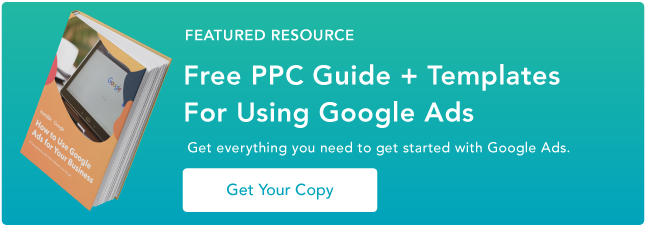With over 3.5 billion search queries on Google everyday, paid Google search — paying Google to advertise your content on SERPs for relevant keywords — is one of the most popular and effective types of online advertising.
However, there’s enormous demand for the top ad rankings for a lot of keywords, and your competitors are duking it out to win the top keywords in your industry. So are you supposed to compete?
Over the past four years, HubSpot has spent millions of dollars and ran over 1,200 controlled experiments on acquiring free CRM users through Google advertisements, learning a ton of new insights and processes along the way. Additionally, HubSpot has launched a free ads tool to help get Google Ads strategies right.
We want to share our learnings with fellow marketers to help everyone save their time, budget, and frustrations.
Read on to learn the eight-step process we use to optimize Google Advertising costs. And if you’re new to Google ads, check out the basics of Google Adwords in the section below. If you already know the fundamentals, feel free to skip it.
Free Guide, Template & Planner: How to Use Google Ads for Business
Google Ads (Formerly Google AdWords), Explained
This section is for those who need a basic crash course in the subject, as well as those who want to refresh their knowledge on Google Ads. Refer back to this section as a quick reference point.
First, you might be wondering how much all of this is going to cost you. Let's talk about that now.
Google Advertising Cost
The CPC average for Google Display Network for the B2B industry is $3.33, $1.16 in Ecommerce, and $3.80 in Technology. The CPC for Google Search Network is $.79 in the B2B industry, $.45 in Ecommerce, and $.51 in Technology. While the average for PPC is between $15 to $800 per month, you can choose how much to spend per campaign.
What do these acronyms mean? Let's break it down:
- CPC — Cost per click (CPC), is the price you pay for each click on a PPC marketing campaign. For instance, if someone clicks on your ad from the Google results page, you would pay a set price for that click. If you pay $100 for your ad and it's clicked on 100 times, then your CPC is $1.
- PPC — Pay-per-click (PPC), is a strategy where marketers pay for their ads to appear in search results for certain keywords or phrases. (Learn more here).
In short, PPC and CPC differ because PPC is a marketing strategy, while CPC is a metric you can use to measure the effectiveness of your overall PPC strategy. As a metaphor, PPC is to blogging what CPC is to views.
On average, the CPC average for Google Display Networks is $1 or less. This means, for less than a dollar, your ad can be displayed on one of the 2 million websites Google has in its network. (Don't worry, Google helps find the right audience).
The CPC for Google Search Network is up to $2 per month. The price is higher because Google Search Network is in reference to the ads displayed at the top of SERPs, and there's more competition for those spots.
What is your competition spending on ads? Well, Google ad spend in the realm of SMBs is between $9,000 to $10,000 per month. As stated above, you can set your budget for campaigns on Google, but keep in mind that this is the median.
Now that you know the cost, let's get into some key terms and phrases to know before optimizing ad spend.
Keywords
From a fifty-thousand foot view, you win ad impressions on Google by bidding on keywords. In other words, you’re asking Google to show your ad to a user when they type a specific search query into their search engine. These search queries are keywords.
For example, if you’re advertising a free CRM, you might want your ad to show up on Google when users type “free crm” into the search engine. Every other brand who wants to win those impressions will set their bids, and based on that and various other factors, Google may choose to display your ad to its users.
Ad Groups
An ad group organizes keywords into different groups. For example, if an advertiser had a “Competitors” campaign, it'd most likely be in a “Marketing Competitors” ad group and a “Sales Competitors” ad group. Within each of these ad groups, the advertiser then might bid on keywords that consist of competitors’ brand names plus each product we both sell.
Quality Score
Aggressively bidding on keywords is not enough to win impressions. You could bid $10 per click while your competitor bids $5 per click, and you could still lose that auction if they have a high enough quality score.
Quality score is a metric that measures how positive and relevant of an experience you are creating for the searcher. A lot of signals are taken into account, two of which are landing page experience and click-through rate.
Google’s top priority is providing their users with a great user experience, so they’d rather give an impression away for free than make $100 per click if the loss in revenue means they can provide a better user experience to their users.
So, organizations can’t acquire the top ranking for any keyword they want just because they have the biggest ad budgets. Their content also has to be relevant.
Match Types
Google Ads offers four match types: broad match, modified broad match, phrase match, and exact match. Recall that match types define categories a search query can fall in.
Here’s a rundown of each:
Broad Match: With broad match, the user just needs to type in one of the words within your keyword or a variant of it, and your ad could show up on their results page. For example, if you bid on “free crm software," your ad could only show up for “crm software” and “adobe software.”
Be careful with broad match, though. Bidding on these type of keywords is the easiest way to burn through a ton of cash without producing substantial results.
Modified Broad Match (MBM): MBM allows you to lock in specific keywords within a phrase. For example, bidding on “free +crm +software” will display your ad on a Google search for “no cost crm software” and “easy crm software," but not on “adobe software.”
Phrase Match: With phrase match, your ad will appear when Google users search for the phrase that you're bidding on, as well as instances where your phrase is before, after, or in between other keywords in the search query. For example, if you bid on “free crm software,“ your ad will show up on Google for “free crm software for small business,” but not for “free software crm.”
Exact Match: Exact match is exactly what it sounds like. If you bid on “free crm software," your ad will only show up if users search for “free crm software” on Google, in addition to other close variants.
Now that we know the basics of Google Adwords, let’s get back on track.
The 8-Step Process HubSpot Uses to Optimize Google Advertising Costs
1. Pick your keywords.
When you first launch your Adwords campaign, start small. Come up with a list of 5-10 keywords and start bidding using modified broad match. For example, if you’re working on a campaign for a free CRM, the keywords “Free CRM,” “CRM Software,” “CRM Reviews,” “CRM Comparison,” and “Best CRM” would be good to start with. Modified broad match will be more expensive than exact match, but it gives Google greater flexibility to display your ads on more search queries than exact match will.
In addition to building a “unbranded” keyword list, like the one above, you’ll also want to build a “branded” keyword list (i.e. “HubSpot CRM”). You should do this for two reasons:
- More clicks: You’re probably thinking, “HubSpot already has the #1 spot on Google for the keyword ‘HubSpot CRM.’ Why would they pay for it?” What you’re thinking is true, but studies show if you also win the top ad spot on the SERP where you’ve already won the top organic ranking, you'll receive significantly more clicks. And given the amount of ads Google displays above the fold these days, I have no doubt in my mind this is accurate.
- Competitor blocking: If we don’t bid on and win “HubSpot CRM,” one of our competitors will. Even if we bid aggressively, our competitors can still sneak a win.
2. Set up your campaigns.
There isn’t a cookie cutter approach to campaign structure, but I’m a strong proponent of a 1:1:1 campaign to ad group to keywords setup. In other words, I like to put one keyword in each ad group and one ad group in each campaign. Setting up your campaign like this can clutter your account from an organization standpoint, but here are two reasons why it’s worth it:
- When you use Adwords, you usually set daily budgets at the campaign level, so this type of campaign set up allows for more flexible spending. This is important because your keywords’ ROI can get maxed out. Adwords is an auction, so if you want to win more impressions, you have to bid more. Eventually, the CPC required to win more impressions won’t be worth it anymore, so you’ll want to allocate your budget elsewhere. You can do this precisely if you categorize each keyword into its own campaign.
- Since Google sets your quality score at the keyword level, you’ll want to set up an ad group for each individual keyword, which are sometimes referred to as swim lanes. By setting up swim lanes for each keyword instead of putting them all in the same ad group, you’ll avoid the unfortunate situation of a few underperforming keywords dragging down the quality score of the entire ad group. If each keyword has its own ad group or swim lane, you can just pause the underperforming keywords’ campaign and no harm will be done anywhere else.
3. Craft your ad copy.
One of the most effective levers you can pull to boost your quality score is Click-through-Rate (CTR). And one of the most effective levers you can pull to boost your CTR is crafting compelling ad copy.
One of the most important principles of Google Ads copy is that you need to signal to Google and their users that your ad is relevant to their search. For example, if you’re bidding on the keyword “CRM Software,” design a completely different ad and landing page than if you’re bidding on the keyword “CRM Reviews.”
4. Set up ad extensions.
There are a lot of useful Google ad extensions, but if there’s one you should always launch with, it’s sitelinks. Sitelinks are the 4-6 links under most Google ads. They take up a significant amount of real estate, boost your CTR, and, best of all, you don’t have to pay any extra money when people click on them.

5. Set up “negative” keywords.
Negative keywords inform Google that you don’t want to bid on a keyword if the user enters a specific word alongside your keyword. There are a lot of different use cases for setting up negative keywords, but here are three big ones to look out for:
- Irrelevance: I helped market a pre-workout at my last company called “volcaNO.” Needless to say, I didn’t want our ads to show up on Google for the keyword “volcano lava,” so I tagged “lava” as a negative keyword.
- Competing with yourself: Remember, Adwords is an auction. So if you have one campaign bidding on “CRM Software” on MBM and another bidding on “Free CRM Software” on exact match, you’ll be competing with yourself if a user searches for “free crm software.” Tag “free” as a negative keyword in the “CRM Software” campaign to avoid cannibalizing your own clicks.
- Low quality: To understand who your business’ ideal buyer is, talk to sales about the type of people who aren’t good fits for your products or services and try to filter them out.
6. Find your top performing keywords.
After you run your campaigns for a while, it’s time to optimize them. The most important Adwords tab in regards to optimizing your campaigns is the “search term report.” The search term report lists out the exact search queries that you’ve paid for for a given keyword. Remember, if you bid MBM on “free crm,“ you’re going to show up on Google for the keywords “free crm for SaaS companies,” “best free crm,“ “free crm to replace excel,” and potentially thousands of others. The search term report will help you filter out your top performing keywords.
If you notice a specific search query performing particularly well, tag it as negative keyword so you don’t bid it against your other keywords, and then break that keyword out into its own campaign. This is the time to double down. You’ll give that keyword its own budget, its own ads, its own display URL, and if you have the bandwidth, even its own landing page.

7. Look for negatives on demo data.
Most people know about negative keywords, but they often overlook negatives on demo data. For example, maybe you notice men under 25 or woman over 60 aren’t converting (all of this data is available in Adwords). You can exclude these segments by adding negatives or bid modifiers to them, which we’ll explain below.
8. Set up bid modifiers.
A bid modifier lets you adjust your bids for specific criteria without having to change the targeting of your campaign or ad group. For example, if you see mobile converting 50% worse than desktop, you can add a -50% bid modifier on mobile clicks. That’ll lower your ad’s bid on mobile impressions, lead to less placements of your ad on mobile, and optimize your budget. Other cool bid modifiers include:
- Age & gender
- Locations
- Hours of the day
- Days of the week
- If someone has visited a page on your site in the last X days
- If someone is on a lead list
The only silver bullet to Google Adwords is testing and learning.
While the process above is what has worked best for HubSpot’s paid acquisition team, the only way to know what works best for your business is to test and learn. So feel free to implement our strategy as a starting point, but we highly recommend you monitor your data closely and develop a process that's more tailored to your own business.












